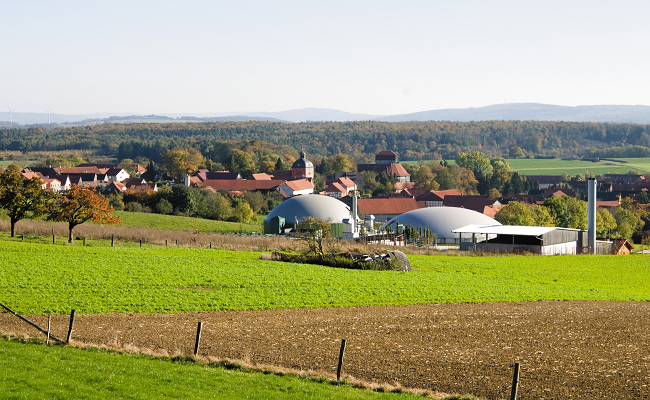Germany’s experiment with bioenergy villages shows that alternative energy sources can spur rural value creation. This has lessons for bioenergy in China.
Despite signals of weaker growth of the Chinese economy, China’s appetite for energy is untamed. The International Energy Agency predicts that more than 1,300 GW of power generation will be added until 2035–equaling the capacity of about 1,000 nuclear reactors. While the share of coal in total energy consumption will be capped, according to plans of the Chinese government, natural gas use is likely to quadruple in the next 30 years. The International Energy Agency also expects that China will experience a bigger increase in generation from renewable energies than the US, the European Union and Japan combined.
With a massive stimulus package and investments into infrastructure, and improvements in the livelihood of the population and industrial development, the Chinese government has proactively tackled the economic disparity between Eastern and Western provinces over the last decade. However, the income gap between urban and rural population is likely to remain an important point on the agenda of future Five Year Plans. The intelligent use of new energy generation technologies can help lowering the inequalities that persist in the urban-rural divide. Germany’s experience in bioenergy villages and micro cogeneration, that is, the combined use of power and heat from the same primary energy source, shows how China’s rural areas could benefit from decentralized energy by creating jobs and increasing energy security.
Germany has embarked on an experiment to fundamentally transform its energy sector. By 2050, the German government plans to obtain 60% of the country’s gross final energy consumption from renewable sources and “a minimum of 80% of the electricity supply is to be generated from renewables”, with an intermediate goal of 35% in 2020. Power from cogeneration is supposed to reach 25%. These goals are ambitious, but–as opposed to China–the country has successfully decoupled economic growth from its energy consumption, which means that the economy is growing while total energy consumption remains stagnant or even shrinks. That makes it easier to achieve these targets. By contrast, China’s population and economy will continue to consume more energy, not less. In order to make life in the countryside more attractive, inhabitants of rural areas will have to be equipped with all the amenities of a modern lifestyle, including energy services that match supply standards in the cities.
Creating Bioenergy Villages
One way of ensuring both local value creation and security of supply are so-called bioenergy villages. In Germany, the number of those villages has increased from one single village in 2001 to more than 130 in 2013. Depending on their resources, these villages use biomass, such as waste from agricultural production or wood pellets, to run cogeneration plants that supply the villagers with electricity and heat. Jühnde, the first German bioenergy village, has received more than 25,000 visitors since it introduced guided tours in 2005, of which 35% come from abroad. Jühnde was launched as a pilot project in co-operation with a university, but as the movement grew over the last decade, most initiatives have been initiated by the villagers themselves.
In the early stages of the movement, the cogeneration technology for biomass combustion was not yet well-advanced, and Jühnde’s technicians had to cope with several obstacles. But now the technology has become fairly standardized, and consulting and engineering practices offer packaged solutions that take the local conditions and differences in the biomass produce into account.
The villagers connect their local electricity grid to the plant and offer heat with a village-wide pipeline system. Often, they finance the system via a local co-operative, where each inhabitant pays some upfront fee to join. In the case of Jühnde, it was 1,500 Euro, which corresponds to around RMB 12,300 (1 Euro equals around RMB 8.2). They then become co-owners of the plant. Grants from local authorities or lending institutions of the German Federal Government complement the investment with favorable loans and credits.
Apart from using local and renewable resources, the switch to bioenergy ensures and increases local employment. Even if the plant itself is erected by professional companies from outside the region, local craftsmen and technicians ensure operation and maintenance of the plant. The financial management is handled by employees or volunteers of the co-operative. The use of local biomass also provides secure and stable returns for farmers. Even the energy utility serving the village may at least partially benefit, because it does not have to invest in reinforcing the copper cables that connect the village to the supra-regional grid when power consumption is growing.
In Germany, the number of energy co-operatives increased from 66 in 2001 to 754 at the end of 2012, with around 130,000 members. Their size ranges from three to over 1,000 people and project volume from 50,000 Euro to more than 20 million Euro. More than 430 of these co-operatives own solar panels, and around 50 are active in biomass and 180 in wind power. The German Renewable Energies Agency estimates that German energy co-operatives have invested around 1.2 billion Euro in so-called “citizens’ power plants”. On aggregate, they supplied 160,000 households with electricity. The Institute for Ecological Economy Research (IÖW) estimates that in 2011 decentralized energies contributed with more than 10 billion Euro to communal value creation in Germany.
China has already gathered experience with decentralized biogas installations since the 1950s. In 2011, more than 40 million households had biogas digesters, and around 80,000 rural biogas plants were in use, mainly in livestock and poultry farms[1]. While they provide gas for cooking and heating, cogeneration plants can lift village-based self-supply to the next, higher level.
In the residential sector, two more technologies are currently in a promising phase of market rollout in Germany: the first one is micro cogeneration, or micro “combined heat and power” (CHP), which is a system that has been specifically developed to satisfy energy demand of individual households. Its energy efficiency is much higher than conventional home energy provision–often more than 80 or even 90%– , because it generates both electricity and heat simultaneously and stores the heat in a small water reservoir until it is needed. Among others, the country’s largest car manufacturer Volkswagen has started producing the micro units and selling them together with a Hamburg-based electricity and gas retailer called LichtBlick. In total, they have already sold more than 1,000 units and have orders for another 500. LichtBlick also trains local craftsmen and technicians who are in charge of taking care of the units once that they are installed. The micro CHP units can be fuelled with biogas or regular, fossil-based natural gas. Due to their high efficiency, they do not only contribute to lowering the energy bill of the households, but also to curb total energy consumption. With China’s plans to exploit its shale gas reserves, micro CHP units would be an ideal substitute for conventional oil and gas boilers.
Heat pumps are the second technology that experiences increasing popularity among German home-owners. They use a small input of electricity and combine it with the thermal energy available in the ground or in the air to provide heating on the household level. As the efficiency of newly built houses increases, the overall heating (or cooling) requirements are substantially reduced, and the installation of a full-fledged boiler or micro CHP unit would be oversized. In these cases, a set of photovoltaic panels on the rooftop combined with a heat pump can lead to a cost-efficient, largely autonomous residential energy supply. In Germany, a quarter of all new heating installations of newly built houses were heat pumps in 2013.
Cogeneration plants in German bioenergy villages as well as micro CHP units in German households are not yet economically viable without subsidies because of stagnating demand and over-supply of energy. But the situation in China is fundamentally different: either electric utilities–and ultimately final consumers–have to finance the construction of new centralized power plants, combined with extending the transmission and distribution grid that transports the electricity to remote villages, or the government provides financial incentives that encourage local energy provision and enhance sustainable value creation on-site. For the reduction of the urban-rural divide, the second alternative seems more promising.
Christoph Burger and Jens Weinmann work with the European School of Management and Technology and are authors of the book The Decentralized Energy Revolution–Business Strategies for a New Paradigm.
(Photo courtesy: Eckhard Fangmeier, CEO of Bioenergiedorf Jühnde)
[1] For further information, see e.g. He et al. (2013). Comparing centralized and decentralized bio-energy systems in rural China. Energy Policy, 63, pp. 34-43

















